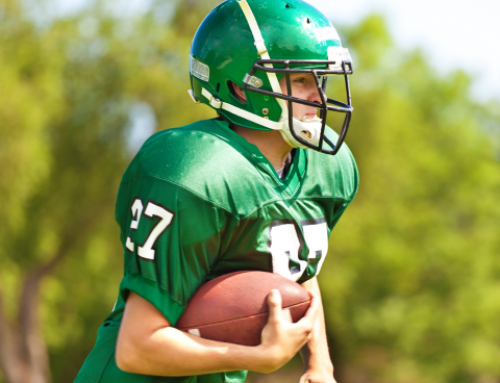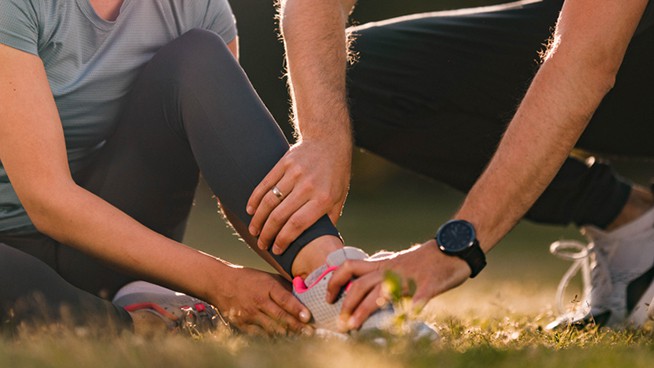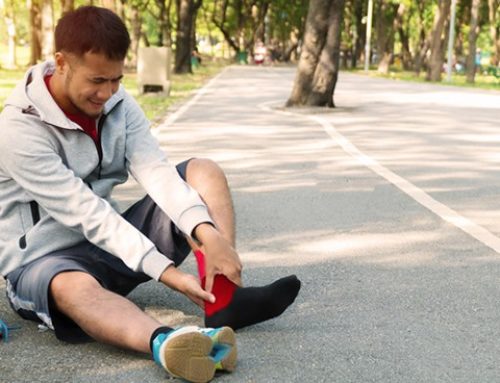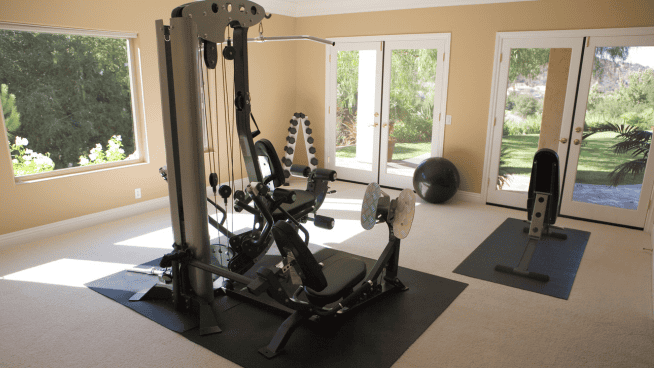How to Fix Bad Posture and Move Better With 4 Exercises
If strength is the foundation for athleticism, then movement quality is the mortar that holds the bricks together. Strength coaches everywhere have come to appreciate that it takes more than Squats, Presses and Cleans to build superior athletes, and that teaching excellent movement patterns is perhaps the most important part of their jobs.
Excellent movement begins with proper posture, which puts the many muscles of the body in the safest and most efficient positions to produce force. Bad posture, on the other hand, leads to a loss of strength and power when it matters most and can predispose an athlete to injury.
How to Fix Bad Posture
Bad posture has many causes, including overuse of certain muscles, poor exercise choices and lack of attention to how we sit and stand. Fortunately, most postural flaws can be fixed with the right exercises and improved body awareness. Here are four exercises to fix bad posture:
RELATED: How to Fix a Forward Head Posture
Problem: Kyphosis (Hunchback)
If you look like Quasimodo from The Hunchback of Notre Dame when you sit or stand, you probably have kyphosis—excessive rounding of the upper back, which leads to terrible mobility in the thoracic spine. Composed of 12 vertebrae that run from the base of the neck to the top of the lower back, the t-spine needs plenty of mobility to properly position the shoulders and core during high-velocity movements like throwing and swinging. If you lack thoracic extension (think “chest up” during a Squat), your lumbar spine often makes up the difference, which is a quick recipe for lower-back pain.
Solution: Foam Roller T-Spine Extension
If you have hopes of ever doing Deadlifts, Squats and Cleans with good form, you’re going to need solid thoracic extension. Improve your t-spine mobility with Foam Roller T-Spine Extensions, which fit perfectly into a warm-up.
How to:
- Lie with your knees bent and your heels and butt flat on the floor.
- Position a foam roller across the back of your shoulders.
- With your hands behind your head and elbows together, arch your upper back around the foam roller, trying to touch your head to the ground behind you.
- Keep your chin tucked, butt on the ground and abs tight to avoid wrenching your neck or lower back.
RELATED: The 10-Minute Workout You Should Do Every Day
Problem: Internally Rotated Shoulders
If kyphosis is the Bonnie of bad posture, internally rotated shoulders are the Clyde. They’re almost always together and always up to no good.
The shoulder is a complex joint with many muscles, bones, nerves and connective tissues fighting for space. If your shoulders are excessively internally rotated (i.e., rounded forward), you narrow that already-tight space, increasing the chance of pain and restricted mobility. A slouched upper back makes matters even worse.
How do you know if you have internally-rotated shoulders? Try the pencil test. Stand up with your hands at your sides and a pencil in each hand. Let your shoulders relax and your arms hang. In which direction are the pencils pointing? If they’re straight ahead, congratulations—you have good posture. If the pencils face toward each other, your shoulders are internally rotated, and your posture needs work.
Rounded shoulders often result from tight pecs and a weak upper back. Ever notice how the dude at the gym who does nothing but Bench Press walks around dragging his knuckles like a gorilla? Don’t be like that guy—that is, if you want mobile, pain-free shoulders.
Solution: Band Pull-Aparts
Fix your posture by strengthening your upper back with Band Pull-Aparts. Don’t be afraid to do lots of high-rep sets. It takes a lot of volume to undo the postural damage caused by too much slouching and heavy benching.
How to:
- Hold a light band at arm’s length with your palms down and hands shoulder-width apart.
- With your chin tucked and abs tight, pull your hands away from each other until the band hits your chest, squeezing your shoulder blades together.
- Slowly return to the starting position and repeat.
Problem: Anterior Pelvic Tilt (Over-Arched Lower Back)
Extension at the upper back is good for posture, but poor posture isn’t limited to the upper body. Too much extension at the lower back is a common problem for many athletes who have to extend their spines when they run, jump, lift or throw.
An over-arched lower back dumps the pelvis forward into a position called anterior pelvic tilt, which can lead to lower-back pain, hamstring strains, a weak core and even disruptions in breathing. It puts excessive stretch on the hamstrings, making them feel tight, all while shutting off the abs and glutes, drastically reducing your ability to control your core. Perhaps most importantly, it limits the function of the diaphragm and makes breathing inefficient, leaving you gasping for air while your opponents leave you in the dust.
Solution: Med Ball Deadbugs
Learn to control your core and protect your lower back with Med Ball Deadbugs. Normal Deadbugs require you to move your opposite arm and leg, but reaching overhead can be a challenge if you have poor posture. Holding the medicine ball makes it easier to keep your abs tight and is a good regression for someone with lousy shoulder mobility.
How to:
- Lie face up on the ground with your hips and knees bent, holding a medicine ball at arm’s length above you.
- Turn on your abs by pulling your ribs down, pressing your lower back into the floor and squeezing the medicine ball as if you were trying to pop it.
- With your feet pointed toward your shins, slowly lower one leg toward the floor, reaching with your heel until the leg is completely straight.
- Keep your abs tight and resist the urge to let your lower back arch.
- Return the leg to the starting position and repeat on the other side.
RELATED: Anterior Pelvic Tilt-A Hockey Epidemic
Problem: All of the Above
Solution: Deadlifts
Besides being an exercise of overall awesomeness, Deadlifts, if done, correctly, are a fantastic way to fix bad posture. Few exercises require the ability to organize all your body parts into proper alignment like the Deadlift.
Think about it—to execute a good Deadlift, you have to:
- Puff your chest out and pull your shoulders back.
- Tuck your chin.
- Hinge at your hips without rounding your back.
- Brace your abs to keep your lower back neutral.
- Do all this with a heavy bar in your hands.
If you can learn to do all of that with a couple hundred pounds, chances are you’re going to fix your bad posture! But be careful—Deadlifts with bad form can make lousy posture even worse. Get a qualified coach to instruct you on good technique so you can build strength and improve posture at the same time.
[youtube video=”MgLQB5MGY7c /]Sample Workout to Fix Your Posture
The first three exercises fit together nicely as part of a warm-up for a strength workout that centers around the Deadlift. You can even repeat some of the warm-up drills with heavier weight and higher reps during the workout to build muscle and strength. Give this a try.
Warm-Up
- Foam Rolling (Upper back, lats, glutes) x 20 each
- Foam Roller T-Spine Extensions x 10 at each position
- Med Ball Deadbugs x 8 each side
- Squat-to-Stand x 8
- Band Pull-Aparts x 20
- Walking Spiderman with Overhead Reach x 5 each side
Workout
- A1. Deadlift from Blocks – 5×5 (use a weight you can lift 7 times)
- A2. Box Jumps – 5×3
- B1. Glute-Ham Raises – 3×8
- B2. Dumbbell Rows – 3×8 each arm
- C1. Medicine Ball Deadbugs – 3×10 each side
- C2. Band Pull-Aparts – 3×20
RECOMMENDED FOR YOU
How to Fix Bad Posture and Move Better With 4 Exercises
If strength is the foundation for athleticism, then movement quality is the mortar that holds the bricks together. Strength coaches everywhere have come to appreciate that it takes more than Squats, Presses and Cleans to build superior athletes, and that teaching excellent movement patterns is perhaps the most important part of their jobs.
Excellent movement begins with proper posture, which puts the many muscles of the body in the safest and most efficient positions to produce force. Bad posture, on the other hand, leads to a loss of strength and power when it matters most and can predispose an athlete to injury.
How to Fix Bad Posture
Bad posture has many causes, including overuse of certain muscles, poor exercise choices and lack of attention to how we sit and stand. Fortunately, most postural flaws can be fixed with the right exercises and improved body awareness. Here are four exercises to fix bad posture:
RELATED: How to Fix a Forward Head Posture
Problem: Kyphosis (Hunchback)
If you look like Quasimodo from The Hunchback of Notre Dame when you sit or stand, you probably have kyphosis—excessive rounding of the upper back, which leads to terrible mobility in the thoracic spine. Composed of 12 vertebrae that run from the base of the neck to the top of the lower back, the t-spine needs plenty of mobility to properly position the shoulders and core during high-velocity movements like throwing and swinging. If you lack thoracic extension (think “chest up” during a Squat), your lumbar spine often makes up the difference, which is a quick recipe for lower-back pain.
Solution: Foam Roller T-Spine Extension
If you have hopes of ever doing Deadlifts, Squats and Cleans with good form, you’re going to need solid thoracic extension. Improve your t-spine mobility with Foam Roller T-Spine Extensions, which fit perfectly into a warm-up.
How to:
- Lie with your knees bent and your heels and butt flat on the floor.
- Position a foam roller across the back of your shoulders.
- With your hands behind your head and elbows together, arch your upper back around the foam roller, trying to touch your head to the ground behind you.
- Keep your chin tucked, butt on the ground and abs tight to avoid wrenching your neck or lower back.
RELATED: The 10-Minute Workout You Should Do Every Day
Problem: Internally Rotated Shoulders
If kyphosis is the Bonnie of bad posture, internally rotated shoulders are the Clyde. They’re almost always together and always up to no good.
The shoulder is a complex joint with many muscles, bones, nerves and connective tissues fighting for space. If your shoulders are excessively internally rotated (i.e., rounded forward), you narrow that already-tight space, increasing the chance of pain and restricted mobility. A slouched upper back makes matters even worse.
How do you know if you have internally-rotated shoulders? Try the pencil test. Stand up with your hands at your sides and a pencil in each hand. Let your shoulders relax and your arms hang. In which direction are the pencils pointing? If they’re straight ahead, congratulations—you have good posture. If the pencils face toward each other, your shoulders are internally rotated, and your posture needs work.
Rounded shoulders often result from tight pecs and a weak upper back. Ever notice how the dude at the gym who does nothing but Bench Press walks around dragging his knuckles like a gorilla? Don’t be like that guy—that is, if you want mobile, pain-free shoulders.
Solution: Band Pull-Aparts
Fix your posture by strengthening your upper back with Band Pull-Aparts. Don’t be afraid to do lots of high-rep sets. It takes a lot of volume to undo the postural damage caused by too much slouching and heavy benching.
How to:
- Hold a light band at arm’s length with your palms down and hands shoulder-width apart.
- With your chin tucked and abs tight, pull your hands away from each other until the band hits your chest, squeezing your shoulder blades together.
- Slowly return to the starting position and repeat.
Problem: Anterior Pelvic Tilt (Over-Arched Lower Back)
Extension at the upper back is good for posture, but poor posture isn’t limited to the upper body. Too much extension at the lower back is a common problem for many athletes who have to extend their spines when they run, jump, lift or throw.
An over-arched lower back dumps the pelvis forward into a position called anterior pelvic tilt, which can lead to lower-back pain, hamstring strains, a weak core and even disruptions in breathing. It puts excessive stretch on the hamstrings, making them feel tight, all while shutting off the abs and glutes, drastically reducing your ability to control your core. Perhaps most importantly, it limits the function of the diaphragm and makes breathing inefficient, leaving you gasping for air while your opponents leave you in the dust.
Solution: Med Ball Deadbugs
Learn to control your core and protect your lower back with Med Ball Deadbugs. Normal Deadbugs require you to move your opposite arm and leg, but reaching overhead can be a challenge if you have poor posture. Holding the medicine ball makes it easier to keep your abs tight and is a good regression for someone with lousy shoulder mobility.
How to:
- Lie face up on the ground with your hips and knees bent, holding a medicine ball at arm’s length above you.
- Turn on your abs by pulling your ribs down, pressing your lower back into the floor and squeezing the medicine ball as if you were trying to pop it.
- With your feet pointed toward your shins, slowly lower one leg toward the floor, reaching with your heel until the leg is completely straight.
- Keep your abs tight and resist the urge to let your lower back arch.
- Return the leg to the starting position and repeat on the other side.
RELATED: Anterior Pelvic Tilt-A Hockey Epidemic
Problem: All of the Above
Solution: Deadlifts
Besides being an exercise of overall awesomeness, Deadlifts, if done, correctly, are a fantastic way to fix bad posture. Few exercises require the ability to organize all your body parts into proper alignment like the Deadlift.
Think about it—to execute a good Deadlift, you have to:
- Puff your chest out and pull your shoulders back.
- Tuck your chin.
- Hinge at your hips without rounding your back.
- Brace your abs to keep your lower back neutral.
- Do all this with a heavy bar in your hands.
If you can learn to do all of that with a couple hundred pounds, chances are you’re going to fix your bad posture! But be careful—Deadlifts with bad form can make lousy posture even worse. Get a qualified coach to instruct you on good technique so you can build strength and improve posture at the same time.
[youtube video=”MgLQB5MGY7c /]Sample Workout to Fix Your Posture
The first three exercises fit together nicely as part of a warm-up for a strength workout that centers around the Deadlift. You can even repeat some of the warm-up drills with heavier weight and higher reps during the workout to build muscle and strength. Give this a try.
Warm-Up
- Foam Rolling (Upper back, lats, glutes) x 20 each
- Foam Roller T-Spine Extensions x 10 at each position
- Med Ball Deadbugs x 8 each side
- Squat-to-Stand x 8
- Band Pull-Aparts x 20
- Walking Spiderman with Overhead Reach x 5 each side
Workout
- A1. Deadlift from Blocks – 5×5 (use a weight you can lift 7 times)
- A2. Box Jumps – 5×3
- B1. Glute-Ham Raises – 3×8
- B2. Dumbbell Rows – 3×8 each arm
- C1. Medicine Ball Deadbugs – 3×10 each side
- C2. Band Pull-Aparts – 3×20










